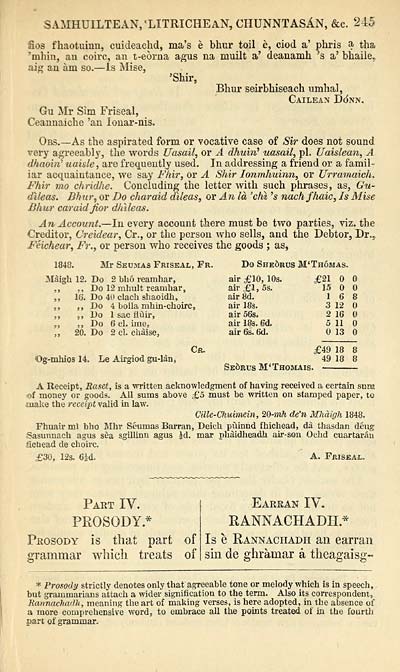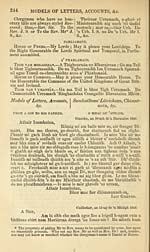Books and other items printed in Gaelic from 1841 to 1870 > Stéidhean a' Ghràmair Ghaëlig
(273) Page 245
Download files
Complete book:
Individual page:
Thumbnail gallery: Grid view | List view

SAMHUILTEÀN, 'LITRICHEAN, CHUNNTASÀN, &c. 245
fios fhaotuinn, cuideachd, ma's è bhur toil è, ciod a' phrìs a tha
'nihin, an coirc, an t-eòrna agus na muilt a' deanamh 's a' bhaile,,
aig an àm so. — Is Mise,
'Shir,
Bhur seirbhiseach umhal,
Cailean Dònn.
Gu Mr Sìm Friseal,
Ceannaiche 'an Ionar-nis.
Obs. — As the aspirated form or vocative case of Sir does not sound
very agreeably, the words Uasail, or A dhuirì uasail, pl. Uaislean, A
dhaoirì uaisle, are frequently used. In addressing a friend or a famil-
iar acquaintance, we say Fhir, or A Shir lonmhuinn, or Urramaich.
Fhir mo chridhe. Concluding the letter with such phrases, as, Gu-
dìleas. Bhur, or Do charaid dìleas, or An là 'chì 's nach fhaic, Is Mise
Bhur caraid Jìor dhìleas.
An Account.—In every account there must be two parties, viz. the
Creditor, Creidear, Cr., or the person who sells, and the Debtor, Dr.„
Fèichear, Fr., or person who receives the goods ; as,
1848. Mr Seumas Friseal, Fr. Do Sheòrus M'Thomas.
Màigh 12. Do 2 blio reamhar, air £10, lOs. £21
,, Do 12 mhult reamhar, air £1, 5s. 15
,, 16. Do 40 clach shaoidh, air 8d. 16 8
,, ,, Do 4 bolla mhin-choirc, air 18s. 3 12
,, ,, Do 1 sac flùir, air 56s. 2 16
„ ,, Do 6 cl. ime, air 18s. 6d. 5 11
,, 20. Do 2 cl. chàise, air6s.6d. 13
Cft. £49 18 8
Og-mhios 14. Le Airgiod gu-làn, 49 18 8
Seòrus M'Thomais. ■
A Receipt, Raset, is a written acknowledgment of having received a certain sum
of money or goods. AU sums above £5 must be written on stamped paper, to
make the receipt valid in law.
Cille-Cliuimein, 20-mh de'n Mhàigh 1848.
Fhuair mì bho Mhr Sèumas Barran, Deich pùinnd fhichead, dà thasdan dèug
Sasunnach agus sèa sgillinn agus id. mar phàidheadh air-son Ochd cuartaràn
fictiead de choirc.
£30, 12s. 6|d. A. Friseal.
Part IV. Earran IV»
PROSODY* RANNACIIADH*
Prosody is tliat part of Is è Rannachadh an earran
grammar which treats of sin de ghràmar à theagaisg-
* Prosody strictly denotes only that agreeable tone or melody which is in speech,
but grammarians attach a wider signification to the term. Also its correspondent,
Eannachadh, meaning the art of making verses, is here adopted, in the absence of
a more comprehensive word, to embrace all the points treated of in the fourth
part of grammar.
fios fhaotuinn, cuideachd, ma's è bhur toil è, ciod a' phrìs a tha
'nihin, an coirc, an t-eòrna agus na muilt a' deanamh 's a' bhaile,,
aig an àm so. — Is Mise,
'Shir,
Bhur seirbhiseach umhal,
Cailean Dònn.
Gu Mr Sìm Friseal,
Ceannaiche 'an Ionar-nis.
Obs. — As the aspirated form or vocative case of Sir does not sound
very agreeably, the words Uasail, or A dhuirì uasail, pl. Uaislean, A
dhaoirì uaisle, are frequently used. In addressing a friend or a famil-
iar acquaintance, we say Fhir, or A Shir lonmhuinn, or Urramaich.
Fhir mo chridhe. Concluding the letter with such phrases, as, Gu-
dìleas. Bhur, or Do charaid dìleas, or An là 'chì 's nach fhaic, Is Mise
Bhur caraid Jìor dhìleas.
An Account.—In every account there must be two parties, viz. the
Creditor, Creidear, Cr., or the person who sells, and the Debtor, Dr.„
Fèichear, Fr., or person who receives the goods ; as,
1848. Mr Seumas Friseal, Fr. Do Sheòrus M'Thomas.
Màigh 12. Do 2 blio reamhar, air £10, lOs. £21
,, Do 12 mhult reamhar, air £1, 5s. 15
,, 16. Do 40 clach shaoidh, air 8d. 16 8
,, ,, Do 4 bolla mhin-choirc, air 18s. 3 12
,, ,, Do 1 sac flùir, air 56s. 2 16
„ ,, Do 6 cl. ime, air 18s. 6d. 5 11
,, 20. Do 2 cl. chàise, air6s.6d. 13
Cft. £49 18 8
Og-mhios 14. Le Airgiod gu-làn, 49 18 8
Seòrus M'Thomais. ■
A Receipt, Raset, is a written acknowledgment of having received a certain sum
of money or goods. AU sums above £5 must be written on stamped paper, to
make the receipt valid in law.
Cille-Cliuimein, 20-mh de'n Mhàigh 1848.
Fhuair mì bho Mhr Sèumas Barran, Deich pùinnd fhichead, dà thasdan dèug
Sasunnach agus sèa sgillinn agus id. mar phàidheadh air-son Ochd cuartaràn
fictiead de choirc.
£30, 12s. 6|d. A. Friseal.
Part IV. Earran IV»
PROSODY* RANNACIIADH*
Prosody is tliat part of Is è Rannachadh an earran
grammar which treats of sin de ghràmar à theagaisg-
* Prosody strictly denotes only that agreeable tone or melody which is in speech,
but grammarians attach a wider signification to the term. Also its correspondent,
Eannachadh, meaning the art of making verses, is here adopted, in the absence of
a more comprehensive word, to embrace all the points treated of in the fourth
part of grammar.
Set display mode to:
![]() Universal Viewer |
Universal Viewer | ![]() Mirador |
Large image | Transcription
Mirador |
Large image | Transcription
Images and transcriptions on this page, including medium image downloads, may be used under the Creative Commons Attribution 4.0 International Licence unless otherwise stated. ![]()
| Rare items in Gaelic > Books and other items printed in Gaelic from 1841 to 1870 > Stéidhean a' Ghràmair Ghaëlig > (273) Page 245 |
|---|
| Permanent URL | https://digital.nls.uk/101714875 |
|---|
| Description | Out-of-copyright books printed in Gaelic between 1631 and 1900. Also some pamphlets and chapbooks. Includes poetry and songs, religious books such as catechisms and hymns, and different editions of the Bible and the Psalms. Also includes the second book ever published in Gaelic in 1631. |
|---|

